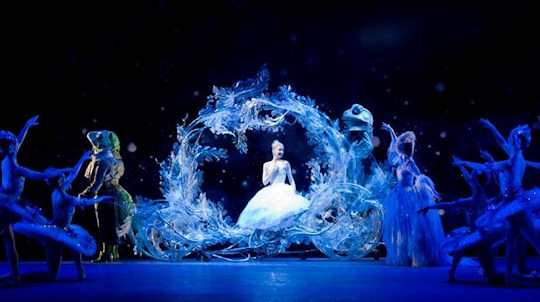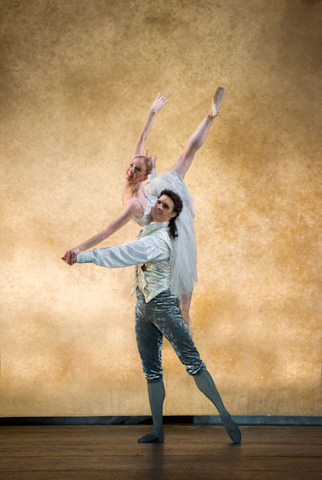Other Links
Editorial Board
- UK Editors
- Roger Jones and John Quinn
Editors for The Americas - Bruce Hodges and Jonathan Spencer Jones
European Editors - Bettina Mara and Jens F Laurson
Consulting Editor - Bill Kenny
Assistant Webmaster -Stan Metzger
Founder - Len Mullenger
Google Site Search
SEEN AND HEARD UK
BALLET REVIEW

Act I
With this production of Cinderella Birmingham
Royal Ballet is celebrating twenty years in their Midlands
home, as well as, emphatically underlining its
independence from the Royal Ballet that set them free
first as the Sadler's Wells Theatre Ballet a long, long,
time ago in 1947. Coincidentally it was for that company
in 1948 that Frederick Ashton created his memorable
Cinderella that this production inevitably must be
compared with. Ashton's Cinderella returns to
Covent Garden again and again and further performances
begin a few days after this BRB's tenancy at the London
Coliseum.
Ideally perhaps, it would have been better to review the
Ashton version first - I first saw that in 1975 with
Makarova - then come to David Bintley's pantomime-light
revisioning of the familiar story. The major difference as
I recall it is that Ashton's Cinderella longs to a
ballerina and in what she suspects is a dream becomes one.
Maybe Ashton takes his cue her from Prokofiev who wanted
his Cinderella to be a 'real person'. It is only when the
Prince appears in Act III and matches the ballet shoe he
has with the one Cinders has in her apron that she
realises that her dream was indeed true.
David Bintley returns to Charles Perrault's original 1697
fairytale for the traditional features of the ballet; the
abused Cinderella, the cruel stepmother, vain stepsisters,
rat coachman and glass slipper etc. etc. He adds to that a
disturbing layer of child abuse but does not take any
'gritty realism' as far as the Grimm Brothers' did when
the stepmother tells her daughters to mutilate their feet
because the glass slipper does not fit! That would be a
Cinderella to see but would not be suitable for
BRB's target audience of pre-teens!
We know we are not in Ashton's Petipa-inspired world right
from the start. In a brief prologue we see Cinderella at
her mother's graveside and her father is latched onto and
consoled by the woman who will become her stepmother. The
stepsisters are mere ciphers here but are soon seen in all
their vain-glory - not as Ashton's circus-clown uglies -
but as one anorexically thin, 'Skinny', and one who stuffs
her face at every opportunity, 'Dumpy'. Both treat
Cinderella appallingly and make fun or her at every
opportunity and, at least for now, every appearance of the
sinister stepmother is accompanied by an appropriate
frisson. Although Cinders treasures her mother's glitzy
slippers she longs not so much to dance but to have her
mother back to love her. We first see the fairy godmother
as a beggar and very touching Cinderella gives her
mother's shoes: they are precious to her but she gives
them up because, though she has nothing herself, the woman
she has met has even less.
Though Bintley and designer John Macfarlane reduce the
stage area and hint at the grimness of Cinderella's
below-stair existence it still is less claustrophobic than
it should perhaps be on the Coliseum's vast stage. It is
also mirth-free until the antics of Skinny and Dumpy being
prepared for the Prince's ball by the dressmaker,
wigmaker, hairdresser and dancing master. So far what we
have had is in keeping with Prokofiev's often angular,
sombre and foreboding score, albeit one that is sprinkled
with own fair share of magic. From now on we are more in a
traditional Cinderella world as though the need
of the box office did not allow Bintley to develop his
ideas exactly as he wanted to. We have the fairies of the
four seasons and a display of silvery tutus much as usual,
plus a humorous gaggle of lizard footmen, frog coachman
and some mice to help with the transformation scene but
the coach itself is a bit of a let-down. Significantly it
is for the first time here we get some real ballet mime
from the fairy godmother.

Act III
Act II is mostly a treat and while the choreography begins
to repeat itself (there are arabesques aplenty and arms
always seem to be in 5th) there is a great deal of comic
detail, including a brief pole-dancing moment for Skinny
(the one who can dance) and wonderful cake-crazed and
orange-chasing moments for Dumpy (who definitely cannot
dance): after their seriousness in Act I they are now more
traditional buffoons. The pas de deux for
Cinderella and her Prince is suitably romantic but easily
forgotten and midnight approaches very eerily as a huge
skeleton clock counts down the time.
At the opening of Act III the tone switches back briefly
to the dark side as we see a pile of discarded shoes and a
posse of women cross the stage desperate to try on the
slipper, the traditional solitary remnant of the now
disconsolate Prince's encounter with Cinderella. All's
well that ends well … for the lovers at least: for me the
ballet ended more with a whimper than a bang. The final
duet for the two lovers is tender and joyful but, again,
is never the grand summation it needs to be in a classical
work like this. In her happiest moments Cinderella is
often accompanied by a starscape (which we are now
familiar with from Professor Brian Cox's recent TV's
programmes that have been so full of physicsbabble):
here with Cinderella and her Prince now united our eyes
are distracted by a large moon that rises in the
background. This reminded me so much of those classic
moments in the last Agony & Ecstasy TV programme
about English National Ballet when Wayne Eagling
considered a balloon the defining moment of his
Nutcracker!
The performances were uniformly splendid without any real
spark of star-quality. Elisha Willis - who had the
difficult task of dancing barefooted for large stretches
of the evening - was a delicate flower, pale and willowy
and played the suffering Cinderella better than the
exalted one when she seemed to lacked the ability to
display the inner radiance required. Both Ms Willis and
her Prince, Iain Mackay, were wonderfully clean and
articulate dancers. He did particularly well in what
remains a very thankless role for a male dancer. Gaylene
Cummerfield and Carol-Anne Millar (in a fat suit) were
very good as Skinny and Dumpy. Momoko Hirata pleasingly
caught the eye as Summer and always scene-stealing, due to
her pervading air of cruelty, was Marion Tait as the
stepmother. It seems often obligatory to ignore the
orchestra and conductor in ballet reviews but I will not
and for me Koen Kessels and the Royal Ballet Sinfonia gave
as fine an account of the score as can be expected given
the exigencies of a ballet performance.
I was a little disappointed with David Finn's lighting as
often some dark, muted colours were often gloomily lit and
dancers were occasionally unnecessarily in shadow. Mostly
I would have just liked even more menace in the
story-telling and bolder - more bravura - choreography for
some of the bigger moments. This is minor quibbling
however as there is so much to admire in this production
and many a child - and inner-child - will (and did) enjoy
it immensely.
Jim Pritchard
Pictures ©
Bill Cooper /Birmingham Royal Ballet
